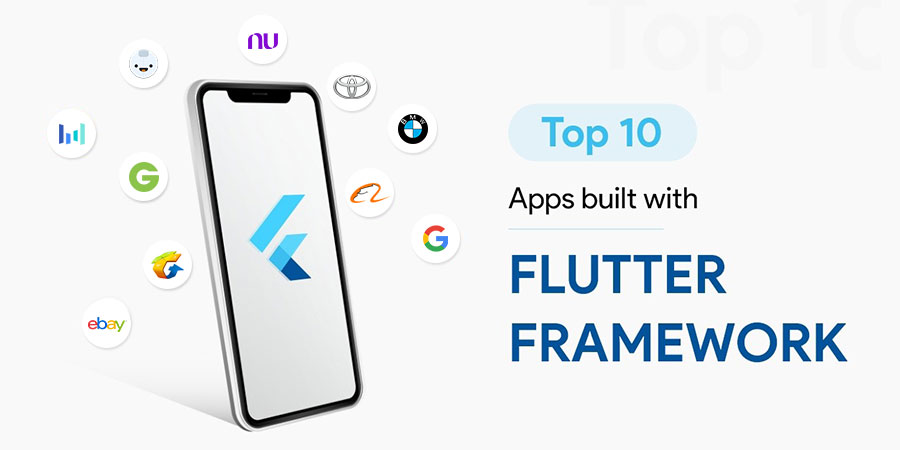The ability to design apps for various platforms with minimal code modifications is no longer a fantasy for developers. The most recent framework to create waves in the field of developing mobile applications is Flutter.
What Is the Flutter Framework?
Released in May 2017, Flutter is a Google-developed, open-source, and free mobile UI framework. It enables you to build a native mobile application using just one codebase, to put it briefly. Accordingly, you can design two distinct apps using a single codebase and programming language (for iOS and Android).
Flutter is made up of two crucial components:
- A group of tools called an SDK (Software Development Kit) will assist you in creating your applications. Tools for converting your code to native machine code are also included (code for iOS and Android).
- An architecture (UI library based on widgets): a set of reusable user interface (UI) components that you may customize for your own purposes, such as buttons, text inputs, sliders, and other elements.
Flutter is gradually becoming the most popular cross-platform framework on the market as more than 10,000 apps have been released using Flutter, which will surprise you. Regardless of market trends, let’s take a closer look at the top 10 apps built with Flutter.
These Are the Top 10 Mobile Apps Built On Flutter Framework
1. Google products – Stadia, Google Ads, Google Assistant
Google Stadia is a mobile gaming streaming platform that works on both iOS and Android smartphones. Stadia development team choose Flutter for the prototyping stage of their project. Later it was revealed that only mobile apps were using Flutter during the initial stages of Stadia’s development. Flutter is also used in the Google Ads mobile app to improve the Google Ads experience and to help advertisers stay connected to their campaigns while on the go. Google uses Flutter for multiple panels of the Google Assistant and the user interface of the Google Home hub.
2. Alibaba Group
Alibaba is one of the world’s most influential online shopping markets. In 2017, they decided to develop a mobile application to help their most successful stores. They were searching for a cross-platform solution as there was a shortage of iOS app developers. Compared to React Native, Flutter’s learning curve is much lower and has a feature called “hot reload.” Because of Flutter’s extensive feature list, Alibaba was able to rapidly develop one of the most successful eCommerce apps currently available.
3. My BMW
The previous version of the My BMW app was primarily designed for iOS, though an Android version was available. The two versions were sufficiently different that BMW looked into alternative solutions. Flutter’s cross-platform development was critical to their decision and quick time-to-market. BMW continues to release new versions rapidly, with over 10,000 versions built in a single year.
4. Toyota
There are many companies that are working to incorporate Flutter into their automobiles, and Toyota is one of them. A keynote address at Flutter Engage from Toyota’s Chief Engineer Daniel Hall detailed four important reasons why Toyota plans to use the Flutter platform:
- High performance under constraints.
- Flutter will help Toyota to construct a smooth-touch in-vehicle user experience.
- Flutter’s ergonomics lets developers use multi-platform tools.
- Faster iteration cycles boost customer experience.
5. eBay
The app enables you to buy and sell vehicles from your phone. In the app, sellers may take a photo of their license plate and it fills out all the vehicle details. eBay Motors is different from other Flutter apps because it follows the Flutter app templates, uses Machine Learning and personalized feeds to automatically classify photos, and is built on the Flutter platform. The application also gives users a customized feed and an easy-to-use interface.
6. Tencent
Tencent got its start with Flutter. It is a well-known name in some of the most popular games and digital content, like League of Legends, Call of Duty, and Honor of Kings. Also, many of its other apps, such as AITeacher, QiDian, and DingDang, use Flutter. Tencent wanted to make the travel, education, and work experiences of its users, among others, easier and more intuitive. Flutter gave them the flexibility and availability they needed by letting them use the same code on multiple platforms.
7. Nubank
For Nubank, Flutter has been a game-changer because it enables them to continue expanding their business without compromising on the quality of their products. Many of their engineers have been able to make the shift to full-stack, which has resulted in an increase in both the productivity of developers and their satisfaction with their work. Because the onboarding process for Flutter is so simple, newly hired engineers are able to begin contributing to the app within only a few days of being brought on board. Even engineers who don’t work on mobile devices can become productive in a few weeks.
8. Groupon App
Groupon is another company that is an excellent example of one that uses a pre-made application. It contained apps that were geared toward the client as well as apps that were geared toward the business. The first one has currently surpassed the 50 million download mark, and the second was far less substantial and had been downloaded more than 500,000 times; incorporating new technology entailed a lower risk level. Instead of completely redesigning the app from the ground up, Groupon decided to combine Flutter with an existing solution.
9. Sonos
Sonos is a music service that connects to other services. The aim is to have all of your music from various services play in a single app. The app’s nature necessitates cross-platform development for iOS and Android, as well as Windows, macOS, and possibly FireOS. Sonos chose to Flutter for speedy cross-platform development after an initial, somewhat unstable release. Sonos’ new version is bug-free and widely available.
10. Reflectly
Reflectly is an AI-based lifestyle application that engages clients to create their own journals, and it is another top app built with Flutter as the foundation. Reflectly was initially built with React Native. However, due to application movement, it did not perform well on Android. Reflectly required the removal of activities in order to be usable. The response system couldn’t handle the perplexing construction, so they switched to Flutter, which provides rich native performance with the lowest crash-down rates.
Wrapping Up
In the world of mobile app development, the Flutter framework appears as a game changer. Developers can build stunning and high-performing mobile apps across multiple platforms using its extensive collection of tools and capabilities. The top 10 mobile apps built with Flutter showcase the framework’s diversity and power, demonstrating its ability to design beautiful user interfaces, deliver smooth performance, and give seamless cross-platform experiences. Flutter is growing as an ideal choice for developers seeking to create cutting-edge mobile apps, whether it’s for eCommerce, social media, productivity, or entertainment.
As the demand for Flutter app development grows, it’s apparent that this framework is changing the way developers create mobile apps. If you also inted to create an app for an upcoming project, Flutter can be the right choice for you. In terms of development, you should hire a group of experts who can create innovative mobile apps and provide you functional, appealing apps that will help your business thrive.





